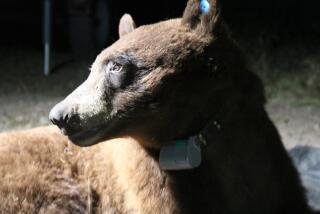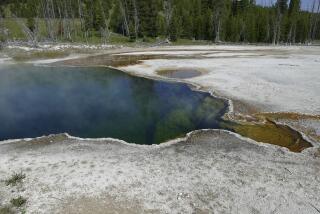Campground Incidents on Rise : Be Assertive With Bears, Visitors at 3 Parks Told
- Share via
Food shortages blamed in part on the drought are driving unusually large numbers of hungry black bears into campgrounds, cars and cabins at three of California’s national parks this summer, and rangers are urging campers to be “more assertive” with the normally timid animals.
Officials at Yosemite, Sequoia and Kings Canyon national parks attribute the rising number of “bear incidents” to food scarcities caused in part by two years of below-average rainfall and a late spring frost this year that destroyed the berry crop, the black bear’s main food source in the summer.
At Yosemite, the number of incidents in which bears destroyed property or stole food rose nearly threefold this year. By the end of June, park officials had counted 177 bear mishaps and estimated damage at $26,893. In the same period last year, there were 65 incidents totaling $3,325 in damage. This spring, bears broke into 17 cabins in Yosemite’s Wawona area, near the southern end of the park.
“Last year, we had fairly good berry crops through the early part of summer and we didn’t get a large increase in bear incidents until late summer and through the fall,” said Jeff Keay, a wildlife biologist at Yosemite. “This year, it started right off the bat in the springtime, and we’ll be busy all summer and fall.”
At Sequoia and Kings Canyon, reported incidents in park areas that are easily accessible to visitors were up 10% to 20% this year. “But in terms of actual incidents, I wouldn’t be surprised if it has doubled,” said Harold Werner, a fish and wildlife biologist for the parks. A bear earlier this month invaded a small grocery store in Sequoia and got away with “$18 worth of food” before being chased out, Werner said.
Park officials say none of the bear incidents involved injuries to humans, and they do not believe the black bears will resort to violence for food. Instead they predict that the bears will simply approach more picnickers and campers in hopes of scaring them into abandoning their food.
“I have been in the business for 14 years and I have never seen that (violence)--including in a drought that was worse than this one. . . ,” said David Graber, a research scientist at Sequoia and Kings Canyon parks. “The bears will just be harder to intimidate, and they’ll take more chances.”
The rising aggressiveness of the bears comes at a time when park officials are encouraging visitors to be “more assertive” with the animals when they approach for food.
Under this policy, visitors are being urged to try to chase away bears by throwing rocks and sticks aimed at the animals’ sides and rears, not their heads.
“The thing to do is immediately jump up and yell and bang pots and pans, throw some small rocks and run toward it,” said Keay. “Chase it a bit but you always want to keep at a safe distance . . . 20 yards. And you don’t ever turn your back and run away from it.”
In the past, park officials encouraged visitors only to make a lot of noise by yelling and banging pots and pans. But recent studies have shown that black bears rarely threaten humans, and the three parks decided last summer to promote the new, get-tough policy.
“We’d be giving people this direction whether there was a drought or not but we have a clearly more desperate situation now,” said Graber. “I think it’s going to get worse rather than better this summer. We have seen animals that are literally starving.”
A normal adult black bear weighs 275 to 350 pounds at the end of the summer. Many young bears this summer are severly underweight; some are as much as 50% below normal.
One of the techniques black bears use to frighten visitors into dropping their food or packs is a “bluff charge,” Graber said. “The bear whoofs at a visitor and then charges at him. But if the visitor doesn’t run away, the bear stops 10 or five feet in front of them. That’s a pretty fearsome stunt but it’s just a stunt.”
But Graber conceded that the new, more assertive bear policy is “loaded with problems” for the parks. “We’re really in a bind over it because if we encourage people to be aggressive around bears and they are injured, we are liable,” he said. “On the other hand, if we encourage them to be meek. . . . We’re producing an absolutely incorrigible bear population. We’re on the horns of a kind of dilemma.”
Graber noted that “accidents may happen. If a bear perceives that somebody is threatening him at close range, he may slap, and a slap can open you right up. When we urge people to be assertive, we’re not talking about hand-to-hand combat.”
Officials at the three parks said wildlife managers elsewhere in the state have reported a similar rash of bear incidents this summer. “There’s been an increase up and down the state,” Graber said. “It (wildlife management) is a tight-knit ground; there aren’t that many people working with bears.”
But Donald Koch, coordinator of the state bear program for the California Department of Fish and Game, was reluctant to attribute increased bear incidents to the drought.
“Certainly in some given locations this year we are having some problems, but I would be leary to blame it solely on the drought because some years, when we have very good rainfall, we have a lot of problems,” he said.
Bears survive largely on grasses and leafy shoots in the spring, berries and insect larvae in the summer and acorns in the fall. The loss of the berry crop this year followed a disastrous autumn for acorns. Park officials speculated that the acorn decline was caused either by the drought or was part of a natural cycle.
“I don’t know what is going to happen this year (with the acorn crop) but I’m not very optimistic,” said Graber. “The trees look terrible because of the drought.”
Officials at Yellowstone National Park in Wyoming, which is having its driest year since 1911, had predicted more visitor encounters with bears this summer because of the drought. But so far, the predictions have proven wrong. Nathan L. Varley, a bear management ranger at the park, said there have been only a few “real minor” reports of property damage caused by bears. “We can’t figure out why,” he said.
Sue Consolo, a management biologist at Yellowstone, said lightning-caused fires may have reduced visitation in the back country, resulting in fewer encounters with bears.
At Yellowstone, officials do not recommend being assertive with bears. In addition to the normally timid black bear, Yellowstone is home to at least 200 grizzlies, which are larger and more ferocious than the black bear. (Grizzlies became extinct in California in 1922.) Many visitors probably would be unable to distinguish between a black bear and a grizzly, and a display of aggression toward a grizzly could result in injury, park officials warn.
Times staff writer Guy Maxtone-Graham contributed to this story.
More to Read
Sign up for The Wild
We’ll help you find the best places to hike, bike and run, as well as the perfect silent spots for meditation and yoga.
You may occasionally receive promotional content from the Los Angeles Times.







